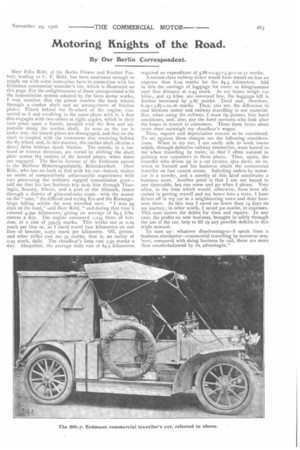Motoring Knights of the Road.
Page 3

If you've noticed an error in this article please click here to report it so we can fix it.
By Our Berlin Correspondent.
Herr Felix Rohl, of the Berlin Flower and Feather Factory, trading as C. F. Rohl, has been courteous enough to supply me with some instrucLive facts in connection with his Erdmann commercial traveller's car, which is illustrated on this page. For the enlightenment of those unacquainted with the transmission system adopted by the Gera motor works, I may mention that the power reaches the back wheels through a cardan shaft and an arrangement of friction plates. Placed behind the fly-wheel of the engine, connected to it and revolving in the same plane with it, a first disc engages with two others at right angles, which in their turn press upon a fourth, parallel with the first and adjustable along the cardan shaft. As soon as the car is under way, the lateral plates are disengaged, and that on the shaft is coupled with the transverse disc revolving -behind the fly-wheel, and, in this manner, the cardan shaft obtains a direct drive without much friction. The speeds, in a forward or reverse direction, are varied by shifting the shaft plate across the centres of the lateral plates, when these are engaged. The Berlin licensee of the Erdmann patent is the Berliner Motorwagenfabrik, Reinickendorf. Herr Rohl, who has no fault to find with his car—indeed, makes no secret of comparatively unfavourable experiences with cars possessing the ordinary cogged transmission gear— told me that his last business trip took him through Thuringia, Saxony, Silesia, and a part of the Alttuark, hence through a district of give-and-take roadswith the accent on the" take," the difficult and trying F.rz and the Riesengebirge falling within the area travelled over. " I was 59 days on the road," said Herr Rohl, " and during that time I covered 4,990 kilometres, giving an average of 84.5 kilometres a day. The engine consumed 1,233 litres of benzine, at a cost of 359.75 marks. This works out at 0.29 mark per litre or, as I could travel four kilometres on one litre of benzine, 0.072 mark per kilometre. Oil, grease, and other trifles cost me 55 marks, that is, an outlay of 40.93 mark, daily. The chauffeur's keep cost 3.50 marks a day. Altogether, the average daily run of 84.5 kilometres required an expenditure of 5.88+0.93+3.50=10.31 marks.
A second-class railway ticket would have meant no less an expense than 6.29 marks for the 84.5 kilometres. Add to this the carriage of luggage for every 10 kilogrammes over that distance at 0.43 mark. As my boxes weigh / so kilos., and 25 kilos. are conveyed free, the luggage bill is further increased by 3.87 marks. Total cost, therefore, 6.29+3.87=10.16 marks. Thus, you see, the difference in. cost between motor and railway travelling is not material. But, when using the railway, I must tip porters, hire hotel omnibuses, and, also, pay the hotel servants who look after the boxes in transit to customers. These three items alone more than outweigh my chauffeur's wages.
Tires, repairs and depreciation remain to be considered. To set against these charges are the following considerations. When in my car, I am easily able to work towns which, through defective railway connection, were barred to me when travelling by train; so that I often succeed in gaining new customers in these places. Then, again, the traveller who drives up in a car creates, ipso facto, an interest in himself and his business which the commercial traveller on foot cannot create. Soliciting orders by motorcar is a novelty, and a novelty of this kind constitutes a business asset. Another point is that I am not bound to any time-table, but can come and go when I please. Very often, in the time which would, otherwise, have been absorbed in getting myself and my boxes into a train, I have driven off in my car to a neighbouring town and done business there. In this way I saved no fewer than 14 days on my journey; in other words, I saved 300 marks, in expenses. 'Phis sum covers the debits for tires and repairs. In any case, the profits on new business, brought its solely through the use of the car, help to fill tip any possible deficits in this triple account.
To sum up: whatever disadvantages—I speak from a business standpoint—commercial travelling by motorcar may have, compared with doing business by rail, these are more than counterbalanced by its advantages."


























